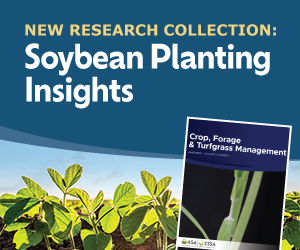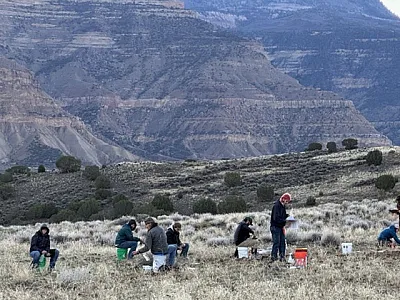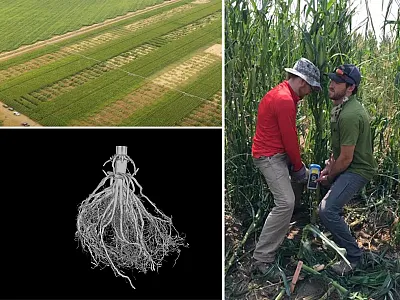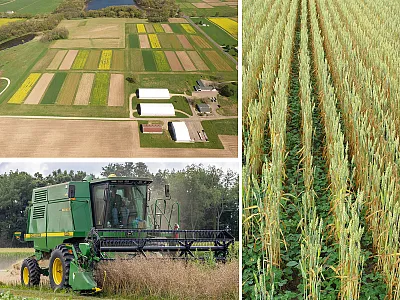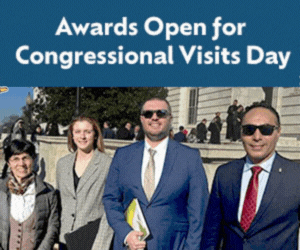Aiming high: crop–soil–agronomy cross-Society objectives

In this article, the presidents of ASA, CSSA, and SSSA introduce the cross-Society objectives of the Societies' strategic plans, describe their connection to the long-term goals and vision of our Societies, and provide the current progress and challenges in their implementation.
Dear members,
It has been five months already since we began our respective terms as presidents of the American Society of Agronomy (ASA), Crop Science Society of America (CSSA), and Soil Science Society of America (SSSA)!
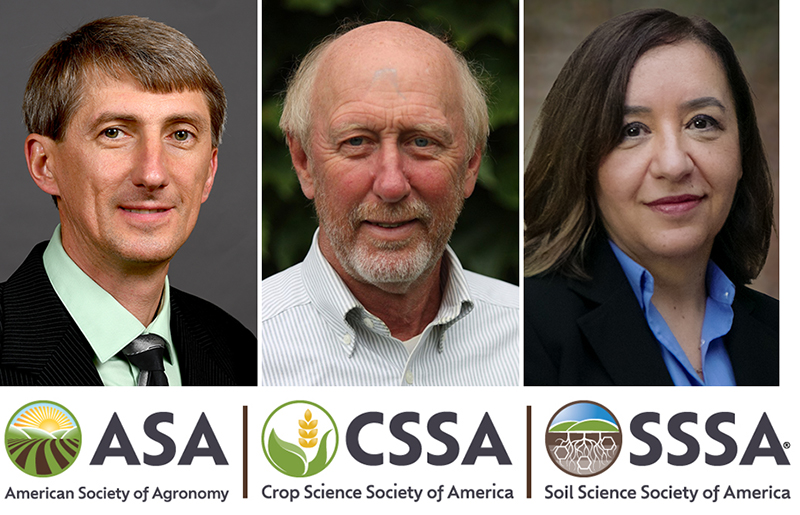
This year is filled with many important developments, and it has been a challenging year for many of our members. ASA, CSSA, and SSSA are working to provide support for USDA research programs that drive innovation in agriculture, food security, and environmental sustainability. The Societies’ leadership met with the House and Senate Agriculture Committee staff, organized Congressional Visits Day and town halls, and is working with aligned organizations and scientific societies to share the impacts of recent political events across food and agriculture research disciplines. All these actions align with the mission and strategic objectives of our Societies.
In 2023, ASA, CSSA, and SSSA engaged in an exercise to update each Society's mission, vision, and strategic objectives. In addition to each individual Society’s strategic objectives, the sister Societies adopted three cross-Society strategic objectives. The purpose of this article is to introduce these objectives, describe their connection to the long-term goals and vision of our Societies, and provide the current progress and challenges in their implementation.
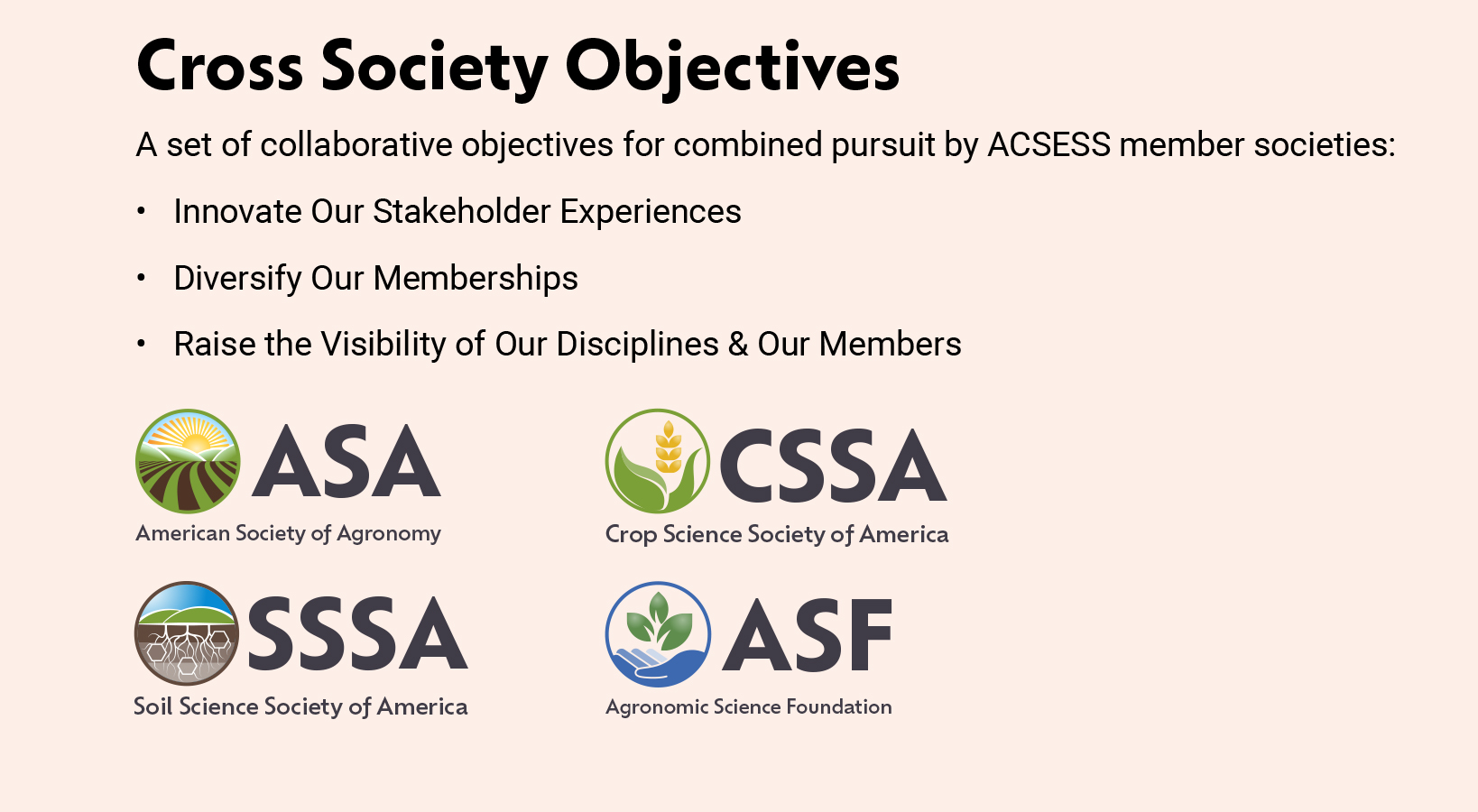
Innovate our membership and stakeholder experiences
Member experience is how our members see, use, and interact with each other and our Societies. Excellent membership experience makes members feel welcome, drives member participation and retention, and attracts new members. Member benefits include access to professional journals, member-specific publications (magazines, podcasts, e-newsletters), meeting discounts, and learning opportunities. As a member, you can grow your career through leadership, professional development, and peer networking. You can sign up for a free three-month trial membership to explore the many benefits of being a member.
An actionable outcome for this cross-Society objective included the launch of the next-generation website in December. The new website structure is designed to enhance the member and stakeholder experience. A unique feature of the new website includes the new “Member Hub,” which replaced the old Discussion Board for the Society sections, divisions, and communities and the volunteer portal. The Member Hub is designed to facilitate networking among our members and enhance meaningful engagement. You can sign up to be part of many Circles aligning with your interests. An exciting addition is the mentor match program, reflecting the Societies’ commitment to professional development of its early career and student members. The mentor program offers a great opportunity to our established members to make a difference mentoring the new generation of scientists in our Societies.
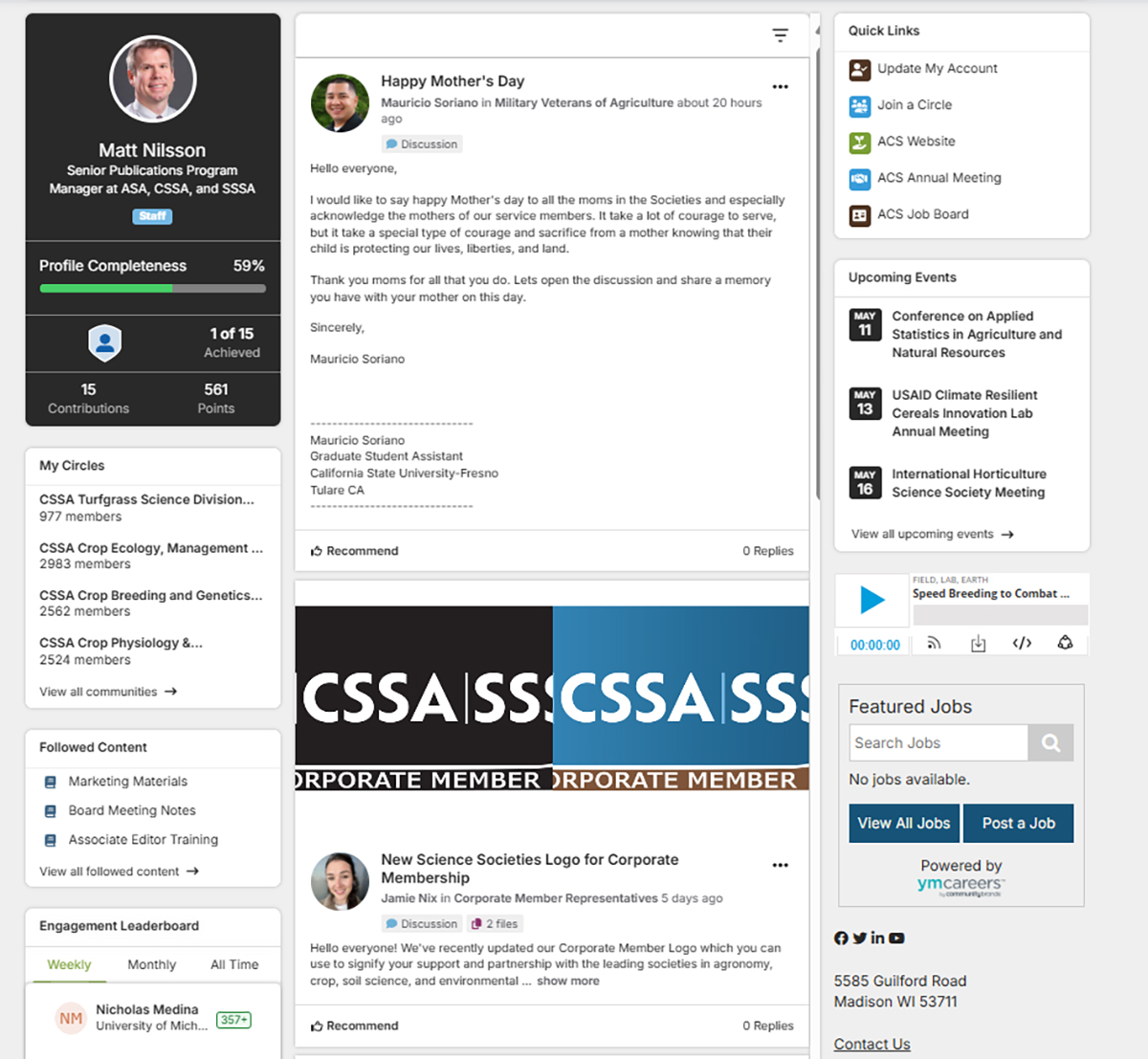
We are happy to report that the Member Hub is being used effectively for interesting discussions, planning sessions for the CANVAS, sharing of recently published articles, and advertising for specialized meetings. Other features include a calendar for upcoming events, links to the Career Center, and recent podcasts from Field, Lab, Earth. Learn more about getting started with the Member Hub.
Another noticeable outcome this year is the transition of the Societies’ two magazines, CSA News and Crops & Soils, from a print to a digital format. While some members are accustomed to reading hard copies and may not fully appreciate this change, the new format offers many new benefits: reduced carbon footprint and production costs, more timely information, dynamic visual features to enhance storytelling and communication impact, no logins/paywalls and expanded scope for greater reach, and the ability to bundle related content and connect to previous stories and scientific publications.
Diversify our memberships
Our traditional membership model was primarily focused on engagement of researchers and students from public universities and employees of federal research and private industry institutions. While this will remain true in the future, addressing complex crops, soil, agronomy, and social-economic problems require a diverse scientific community with different views, expertise, and perspectives. In addition to scientific expertise, there is also a need for engagement of different stakeholders, producer organizations, certified professionals, and policymakers.
The future of our Societies will also depend on our youth and younger members. Our goal is not only to attract undergraduate and graduate students, but also promote and incentivize their membership retention after they graduate from colleges and universities. Early this year, the Societies initiated a plan to renew the K-12 committee to research, develop, and implement plans for outreach to teachers in K-12. The objective is also to increase the teaching of agronomy and soil and crop sciences in K-12 classrooms and build interest and awareness of our sciences as a scientific pursuit and career choice. While K-12 teachers are the primary audience for the outreach, K-12 students will be considered.
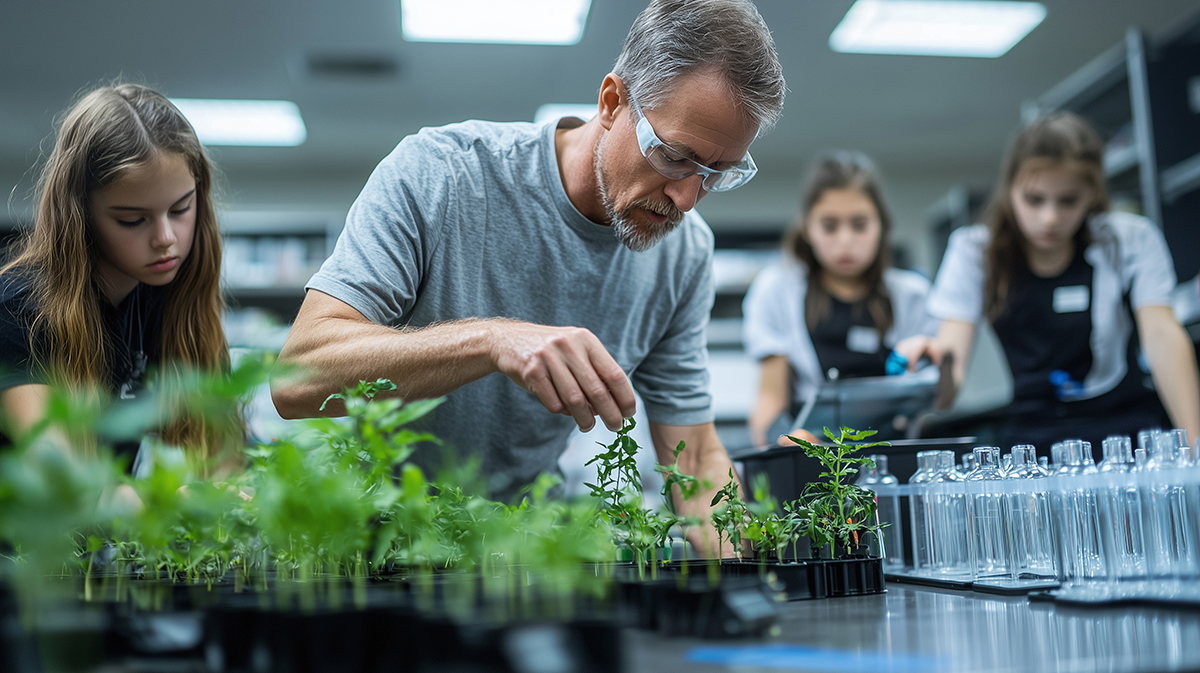
The reach of our Societies extends beyond the USA. We aim to increase the international membership and footprint through scientific and technical engagement and discount membership pricing.
Corporate membership is another option to diversify our membership. Corporate membership is available at three levels (Platinum, Gold, and Silver), providing levels of access depending on company needs. Benefits include webinar sponsorships, employee education packages, and CANVAS sponsorships and exhibitor benefits
Raise the visibility of our disciplines and members
As scientists, students, and certified professionals, we all have a role to play to raise the visibility of our sciences and serve as advocates for important policy issues related to agriculture, environmental sciences, and natural resources. We often do that in our classrooms, at extension events with our stakeholders, or in a more formal way visiting with representatives in our own states or in Washington, DC. The science policy committees of the Societies offers a wonderful opportunity every year for our ASA, CSSA, and SSSA members to become a crucial voice in DC through Congressional Visits Day (CVD). The CVD is an annual event that brings ASA, CSSA, and SSSA members to Washington, DC to meet with their members of Congress and advocate for agricultural research funding.
The 2025 CVD was held this year in Washington, DC on February 25-26. This year, we had 53 participants with 21 students, including undergraduate students. Certified Crop Advisers were also well represented in the CVD delegation. The first day of the CVD was spent on in-depth training on best practices to engage with our elected officials and advocate for science. The day also included a visit from USDA-NIFA leaders with a message of appreciation to the role the Societies play in advocating for continued and increased research funding for USDA-AFRI and Agriculture Advanced Research and Development Authority (AgARDA) programs. Finally, the first day ended with a panel of DC staffers who gave excellent tips and recommendations on making a successful ask.
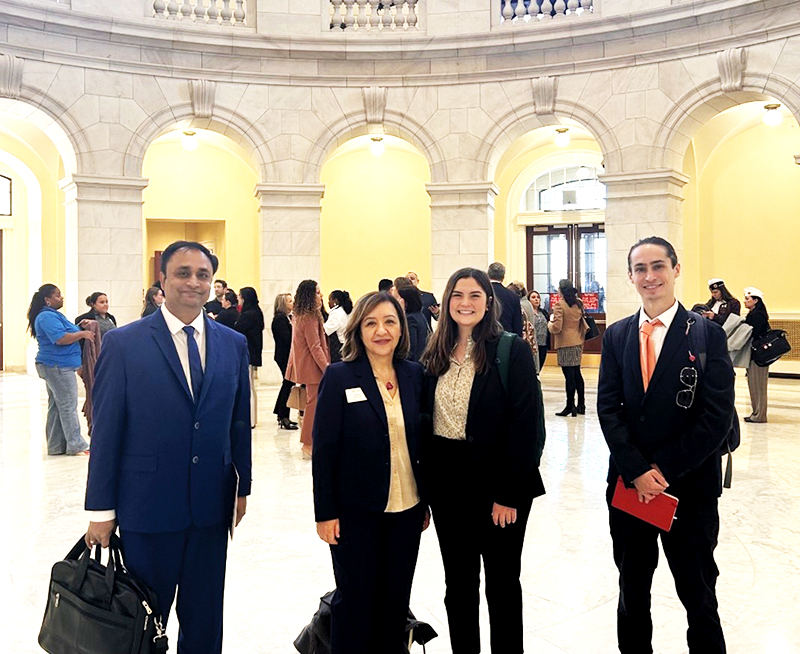
Members of Congress are often seeking constituent input on policy issues, especially from scientists who are viewed as trusted sources of information. That’s where members of the Societies come in! In-person advocacy is effective and impactful, and we hope this year we made our voices heard clearly. During the second day of the visit, the various delegations visited with 89 members of Congress from 31 states. We advocated for increased funding for NIFA-AFRI, which supports a wide array of research projects related to agriculture, environment, and natural resources. Our delegations spent considerable time discussing the impacts of recent funding cuts on research and voiced our strong support for research in support of American farmers and ranchers and for preserving our natural resources. Our message was clear: Food security is national security. Research at universities and USDA is an integral part of that process, ensuring nutritious affordable food for the nation.
Various awards and opportunities are available for our members to engage and raise the visibility of our sciences and members:
The ASA, CSSA, and SSSA Congressional Science Fellowship selects one member to spend one year in Washington DC applying their professional and scientific expertise as a special assistant on the staff of a member of Congress or congressional committee.
The Future Leaders in Science award is an opportunity for graduate students to engage with policymakers and advocate for food, agriculture, and natural resources research funding.
For more information on how to get involved, please visit this page, which includes a detailed “advocacy toolkit.” You can reach your member of Congress and share the value of USDA research, join a policy circle on the Member Hub, and volunteer to serve on one of the science policy committees.
Webinars also serve to engage our members and increase the reach of our Societies. They also help certified professionals receive continuing educational units (CEUs) to maintain their professional competence and technical expertise. Registration includes access to the live broadcast and a link to the recording. For example, webinars in April included “Growing Your Career in Soil Science and Planetary and Space Sciences” and “Exploring the Peer Review Process.” View upcoming webinars and past webinars and online courses.
Please feel free to connect with any of us with questions or suggestions on how best to serve you moving ASA, CSSA, and SSSA forward. We are always happy to hear from our members.
Text © . The authors. CC BY-NC-ND 4.0. Except where otherwise noted, images are subject to copyright. Any reuse without express permission from the copyright owner is prohibited.




